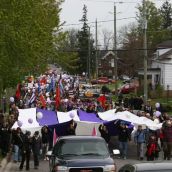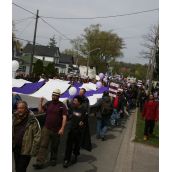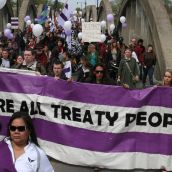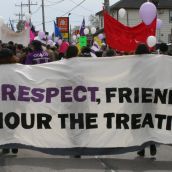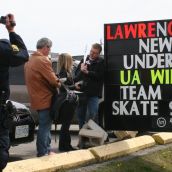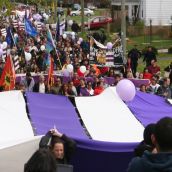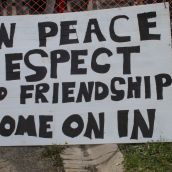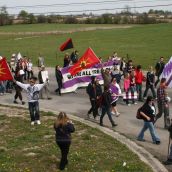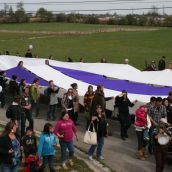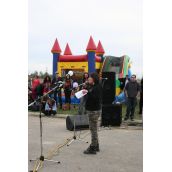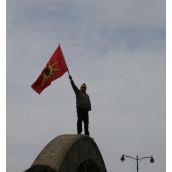check http://april28.net for more info on the Walk for Peace, Respect, and Friend Ship
The following text along with an invitation peace walk and a series of “frequently asked questions” was mailed to more than 5000 homes in and around Caledonia by the April 28 coalition.
For hundreds of years, the Haudenosaunee confederacy of the Six Nations (consisting of the Mohawk, Oneida, Onondaga, Cayuga, Seneca and Tuscacora nations) has exerted their influence over eastern North America. Originally based in the Fingers Lake region of what is now New York State, the Haudenosaune confederacy controlled land and resources including much of Southern Ontario. The confederacy was originally created to bring peace to its warring member nations. It still meets and functions today as the Haudenosaunee Confederacy Council.
In 1613, Five Nations made their first trans-Atlantic diplomatic agreement with the Dutch. After the British defeated the Dutch half a century later, they adopted the same treaties. The British knew that if they wanted to trade and make settlements in North America they needed the support and friendship of the Haudenosaunee.
These treaties and all subsequent ones that the Haudenosaunee made with European nations were based on the concept of the Gus-wen-tah or “two row wampum,” which guaranteed “respect and equality” between the nations making the treaty. The historian Ray Fadden describes the two row this way:
We will not be like Father and Son, but like Brothers. [Our treaties] symbolize two paths or two vessels, travelling down the same river together. One, a birch bark canoe, will be for the Indian People, their laws, their customs and their ways. The other, a ship, will be for the white people and their laws, their customs and their ways. We shall each travel the river together, side by side, but in our own boat. Neither of us will make compulsory laws nor interfere in the internal affairs of the other. Neither of us will try to steer the other’s vessel.
The Two Row is symbolized in a wampum belt by two purple rows against a white background. The white beads symbolize the principles of Peace, Respect, and Friendship. The two purple rows symbolize the independent paths of the Haudenosaunee and the new comers to the Americas.
The two row said that both European and Indigenous peoples can use this land, but only on the basis of mutual respect and non-interference with each other’s way of life.
Unfortunately, the British crown and the Canadian government have not lived up to the principles of the two row. In 1784, due to their role as allies to the British Crown, Six Nations was granted some 950 000 acres of land along the Grand River in the Haldimand proclamation. The document stated that Six Nations “and their posterity are to enjoy [these lands] forever.”
Six Nations was forced off of much of their land by squatters. In other areas of the Haldimand tract they leased the land to non-natives, but they never received payment. Corrupt government officials stole from the Six Nations trust fund, and money was diverted for other purposes. Today, Six Nations is upset to see developments taking place across their lands without compensation or consultation.
Nor were the British and Canadian governments content to simply steal Six Nations land. They also wanted to extinguish Haudenosaunee language and culture. Six Nations’ children were taken away from their families, put in residential schools where they were beaten for speaking their own languages, and often sexually assaulted and abused. Through a combination of violence and neglect many children died in these schools.
The organizers of the April 28 peace walk believe that in order for there to be a real and lasting peace between our communities, there must be justice. And in order for there to be justice, the wrongs that the Canadian government and the British Crown have committed against the people of Six Nations must be redressed. Our walk will draw attention to these issues. If we can resolve them we believe that we can create the basis for true and lasting peace, respect, and friendship.
We think that non-native people need to return to the principles of the two row. The two row belongs to us as well as to the Haudenosaunee people. All non-native people living on these lands are treaty people. It was these treaties which give us the right to live here in North America. We must honour and uphold the agreements our ancestors made with the Haudenosaunee people to respect their way of life and their lands and resources.
We also know that there are many ways in which we as working people can benefit by standing together with the people of Six Nations. We don’t want our rural communities destroyed by suburban sprawl. We don’t want local businesses driven out by big box stores. We don’t want developers and the corrupt politicians they have purchased to be running our towns. We all benefit from the actions that Six Nations takes to stop toxic waste and increased pollution on the Grand River watershed. Over the past six years many non-natives have stood with Six Nations in supporting their land rights and they have stood with us – on our picket lines when we were on strike, and together when we have tried to stop the pollution of our shared environment.
Over the past six years, we have helped to build solidarity between natives and non-natives. We have sought a peaceful resolution to conflict and recognized the importance of native land claims.
While some of this work has been public, much more happens without being covered by the media. Coalitions and friendships have been made. Union members, Six Nations people, non-unionized working people in Caledonia, and working people from elsewhere in the Haldimand region have all come together to work for justice. Many meetings, marches, conferences, potlucks, and information events have taken place. Join us on April 28th and work with us in the months and years to come. By honouring the treaties and respecting the principles two row, we can achieve justice and reach the goals of peace, friendship, and respect that we all hold dear.
Please display this poster in your window if you support the principles of the two-row. If you want more info check out www.april28.net, email infoapril28@gmail.com or call 905-481-0072.
